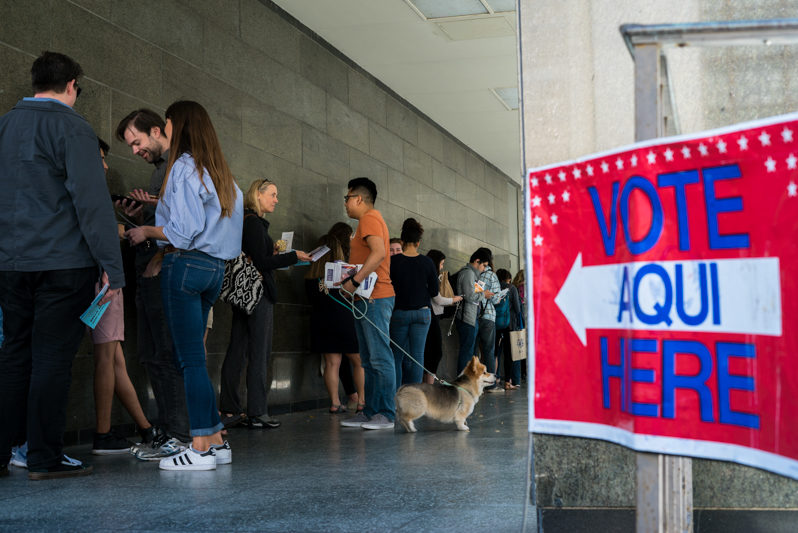Coming in 2020: More Secure Travis Voting System with Paper Trail
By Christopher De Los Santos
Reporting Texas

Austin voters choose their candidates in the March primary election. Come November 2020, they and other Travis County voters will use a new electronic voting system. Photo by Andrea Garcia/Reporting Texas
This story has been revised to clarify that voters deposit their paper receipt into a ballot box at the polling station.
Travis County election officials say they are back on track to have a new electronic voting system that will be ready for the 2020 presidential election — 12 years after county officials began development of a new system.
Voters who go to the polls that November will get a paper receipt showing how they voted. It will tie to a database that will show the votes but not who cast them. That will allow the county to conduct post-election audits of the results.
The system also will have end-to-end encryption, currently the most secure and most hacker-proof way of recording votes. It insures that votes are cast as intended and counted as cast.
“We will get better security and a paper trail, guaranteed. That’s what Travis County voters demanded,” said Lori Clyde, the county’s purchasing agent on the project.
The county plans to choose a developer within the next month.
“The new system will cost between $12 million and $16 million,” said County Clerk Dana DeBeauvoir, the top election official. “But it will be worth it to give our taxpayers and voters the best system possible.”
Verifiable paper documentation is a key goal for DeBeauvoir.
“Our new voting system will contain a paper audit trail for the voter to use in order to ensure that the selections they make on the electronic marking device match their intent,” DeBeauvoir said. “That piece of paper will then be deposited into a ballot box at the vote center, maintaining the anonymity of the vote and allowing us to audit the election results at a later date.”
Down the road, the county would like a method to allow for independent verification of results by third parties such as the League of Women Voters or the NAACP, but that functionality might not be available by 2020, she said.
The new system will replace the Hart eSlate direct recording electronic system in use since November 2001. Annual renewal of the software license costs about $250,000.
In 2005, DeBeauvoir started discussions with her staff on the specifications that would become what the county called STAR-Vote. The acronym stands for Secure, Transparent, Auditable and Reliable.
In 2008, she began collaborating on developing the system with two Rice University experts — computer scientist Dan Wallach and Michael Byrne, who works in user interfaces — and other academics. The goal was to create an electronic voting machine that produced a paper document that could be linked to the electronic record in the database.
Early in 2017, the county put out a request for proposals on that system. None of the 12 companies that responded met all of the desired specifications, and the county canceled the project last fall.
But at about the same, last September, the U.S. Election Assistance Commission issued new voluntary guidelines for electronic voting systems. The guidelines overlapped with what the county was seeking, giving it new leverage with system manufacturers. The county issued a new request for proposals, and Clyde said four companies responded by the December deadline.
Three of the proposals meet quite a few of the STAR-Vote specifications and the companies can deliver the systems in time for use in the 2020 presidential election, she said.
The fiscal 2018 county budget includes $4.1 million for new election systems, according to Budget Director Travis Gatlin. He said that amount will get the process started and then commissioners will decide on funding for the complete system. Gatlin also expects all cities for which the county runs elections to contribute.
No federal money is available, Gatlin said, despite continuing concerns over Russia’s attempts to interfere with the 2016 presidential election, including attempting to hack voter registration rolls in 21 states and succeeding in a few cases. Texas officials have said that no one penetrated Texas voting systems.